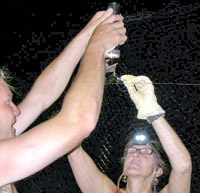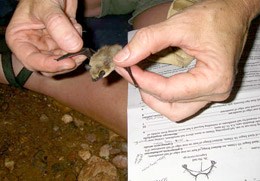|
Bat Survey Documents Grand Canyon Populations and Nursery Colonies
Available as an audiocast read by Shannan Marcak. Duration 3:26 (2.76MB) PLAY NOW https://www.nps.gov/grca/photosmultimedia/upload/20090218_bats.mp3 Ranger Pam Cox has initiated the first survey of bat populations in Grand Canyon National Park since a baseline survey was completed in 1996 – 1997. Pam is one of the interpretive rangers stationed at Phantom Ranch, and is volunteering her time to the Division of Science and Resource Management in order to conduct the bat survey. At least 20 species of bats have been documented in Grand Canyon National Park, with 5 or 6 species common in the canyon. The western pipistrelle bat is the species most commonly observed as they are the small bat seen feeding on insects at dawn and dusk. Other common species of bats at Grand Canyon include the pallid bat and the Mexican free-tailed bat. 
NPS Photo Pam also visited Last Chance Mine, an abandoned copper adit, near the Grand View Trail on Horseshoe Mesa. A 1988 report indicated that a nursery colony of Townsend’s big-eared bats was found there. In late June, Pam observed 39 Townsend’s big-eared bats emerging from the Last Chance Mine indicating that it is still an active colony. 
NPS Photo |
Last updated: July 24, 2015
